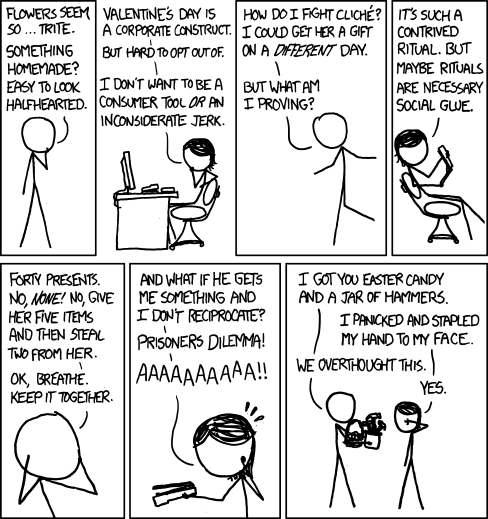Experiment Decisions
Prof Randi Garcia
February 14, 2018

Reading Free-Write (5-7 minutes)
Think of the research question you were assigned to on Monday. You can read on the project page if you'd like.
- What is a potential response variable for a study that answers this question? How could you measure it on a ratio or interval scale?
- What is a potential explanatory variable? What conditions could you create to study this variable?
- What might be the material you assign to these conditions?
Announcements
- HW 2 grades up on Moodle
- Plus 2 points for everyone, 13a, 16, and 17, were often missed.
- I will be dropping the lowest HW grade at the end.
- HW 3 due Friday by midnight on Moodle! (due to snow day)
Agenda
- Get into project groups and start discussing
- Informal Analysis and Six Fisher Assumptions
Measurement Scale
Categorical
- nominal: alcohol drinking (yes/no) of college students
Numerical
- ordinal: “small,” “medium,” and “large” size drinks at a movie theater.
- interval: scores on a “self-esteem” scale of middle- and upper-level managers
- ratio: students’ individual times to complete cognitive task (e.g., 2:15, 2: 21, 2:33, etc.)
Project Proposal due Monday, Feb 26th
Group Discussion Questions
- What might be our response variable be? Can it be measured on an interval or ratio scale?
- What might we choose as our factors/conditions? What stimuli will we have to create these conditions? (practical considerations)
- What is the material we will be using? What are the units?
Six Fisher Assumptions
Six Fisher Assumptions
- C. Constant effects
- A. Additive effects
- S. Same standard deviations
- I. Independent residuals
- N. Normally distributed residuals
- Z. Zero mean residuals
Simulation Activity: Assembly Line Metaphor
- Simulation code/lecture.
- Get into pairs.
- Talk about where the six assumptions are present in the simulation.
C. Constant effects
We assume every observation in a similar condition is affected exactly the same. (Gets the same true score).
animals_sim <- animals %>%
mutate(benchmark = mean(calm)) %>%
group_by(animal) %>%
mutate(animal_mean = mean(calm),
aminal_effect = animal_mean - benchmark)
A. Additive effects
We add the effects as we go down the assembly line.
The interaction effect captures the possibility that conditions have non-additive effects, but it is also added to everythign else.
calm_sim = benchmark
+ aminal_effect
+ cue_effect
+ interaction_effect
+ student_effect
S. Same standard deviations
The peice of code for adding error is not dependent on which condition the observations is in.
+ rnorm(64, 0, 0.65)
I. Independent residuals
Takes 64 independent draws from a normal distribution.
+ rnorm(64, 0, 0.65)
N. Normally distributed residuals
It's rnorm(), and not rbinom() or rpois()…
+ rnorm(64, 0, 0.65)
Z. Zero mean residuals
The second argument is the mean.
+ rnorm(64, 0, 0.65)
Homework 3 Time
- Due on Friday
- Detailed instructions HERE